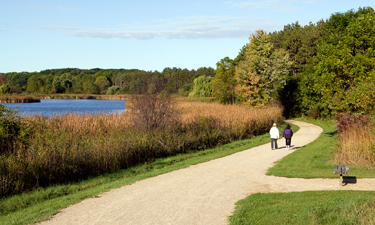 Since the early 1900s, Illinois residents have taken seriously the value of wide expanses of natural prairie, forests, streams and rivers. In 1911, the Chicago-based Forest Preserve District Association pushed for legislation to facilitate protection of the state’s natural areas, and in 1914, the first Forest Preserve District was established in Cook County. Forty-four years later, Lake County would follow suit, establishing its own forest preserve, which today encompasses more than 30,000 acres of property. Today, officials of Illinois’ second-largest forest preserve district are turning their attention to the future, crafting a strategy to make sure the assets they’ve spent more than 50 years acquiring remain healthy and available to future generations. Other park and recreation agencies nationwide may be able to follow their example for similar conservation efforts.
Since the early 1900s, Illinois residents have taken seriously the value of wide expanses of natural prairie, forests, streams and rivers. In 1911, the Chicago-based Forest Preserve District Association pushed for legislation to facilitate protection of the state’s natural areas, and in 1914, the first Forest Preserve District was established in Cook County. Forty-four years later, Lake County would follow suit, establishing its own forest preserve, which today encompasses more than 30,000 acres of property. Today, officials of Illinois’ second-largest forest preserve district are turning their attention to the future, crafting a strategy to make sure the assets they’ve spent more than 50 years acquiring remain healthy and available to future generations. Other park and recreation agencies nationwide may be able to follow their example for similar conservation efforts.
Ethel’s Plan, 1958–present
Lake County may not have ever established its forest preserve district if not for the efforts of citizen Ethel Untermyer. Prompted by her son Frank’s request for a fun day of exploration in a local wood, Untermyer inquired where she might find a spot of land for the child to play. She was surprised to learn Lake County had no forest preserves, so she set about organizing a county referendum with the goal of establishing an official forest preserve district. Following an intense lobbying campaign among the county’s 300,000 residents, Untermyer’s referendum passed with 60 percent of the vote. Two years later, in 1961, Lake County’s first preserve was established at Van Patten Woods near Wadsworth, Illinois.
Forest preserves are unique to Illinois and are meant for educational opportunities and recreation activities like hiking and mountain biking. Untermyer’s efforts charged county officials with acquiring huge swaths of property to be put under the forest preserve umbrella. That’s precisely the plan Lake County Forest Preserve District (LCFPD) commissioners followed, establishing goals for open space acquisition based on population size and meeting those metrics. Today, LCFPD includes more than 60 wooded areas, expanses of prairie, trails, lakes, welcome centers, historic landmarks, golf courses and meadows. “We’re almost plateauing in terms of land (acquisition), so now we need to be stewards,” Ann Maine, LCFPD president, says. “The first 50 years were about getting the land and preserving it. Now that we have the land, we have to make a plan and a vision for how to take care of it and what we want to see, You can’t just hold on to it — you need active management.”
Crafting a New Strategy
The “100-Year Vision for Lake County” lays out what Ty Kovach, LCFPD executive director, Maine and their working partners believe is a comprehensive strategy for preserving and cultivating appreciation for the county’s wild open spaces. Kovach, who joined LCFPD in early 2013, just months before the planning process began, said he was inspired in part by NRPA’s three pillars: conservation, health and wellness, and social equity. “When I [was hired at LCFPD], I immediately wanted to begin the strategic planning process,” Kovach says. “I looked at [NRPA’s three pillars] and thought, wow, that’s really concise — literally a one-page statement of what I wanted to do. NRPA had the conservation element, but what really caught my attention was health and wellness and social equity.” The 100-year plan identifies three key areas: leadership, conservation and people, and it details how LCFPD will leverage these assets and ideas to care for their beloved lands, forests and waterways through the next century.
Kovach conducted an extensive data- and comment-gathering process, inviting business leaders, residents, fellow conservationists and planners to the table, and coming up with concise action steps for going forward. Kovach says he thinks in “100-year chunks,” because thoughtful conservation requires one to take the long view. Now that data and stakeholder contributions have been gathered, LCFPD’s plan is on course for implementation in mid-June. “The next thing is outreach,” Kovach says. “We are going to want to step back with the influence and depth of knowledge we have, and focus on outreach through education and communication. I look at it like a relay race. We want to prepare the next generation to take the baton. We hold the baton; now we need to successfully hand that off by really focusing on education, communication, and why it’s important to have open lands and protect, preserve and restore them.”
Samantha Bartram is the Associate Editor of Parks & Recreation Magazine.

